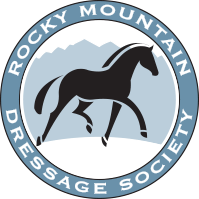Rein-Back: 50 Years of RMDS. Features from the Archives
Put Your Best Foot Forward By Natalie DeFee Mendik
The clinician you’ve always admired is coming to teach at an RMDS-sponsored event. Before you get too excited about riding, you may first need to put together a video for a selection committee to review with your application. As with anything in life, you want to present your best self. RMDS reached out to fellow USDF Group Member Organization (GMO), New England Dressage Association (NEDA) for tips on the video process to optimally present horse and rider pairs and to streamline viewing for the event’s selection committee.
With an annual Fall Symposium featuring world-renowned trainers including Carl Hester, Dorothee Schneider, Charlotte Dujardin, Kyra Kyrklund, Robert Dover, Ingrid Klimke, Christoph Hess, and more, NEDA is well aware of the importance of demonstration video clips when putting together the horse and rider lineup. NEDA’s Fall Symposium organizer and ‘R’ Dressage Judge, Beth Beukema, shares some guidelines NEDA has developed over the years:
- “We require applicants send a link to a video upload of a complete test from start to finish,” Beukema notes, “because you can edit anything to look good.” This unedited ‘X to X’ test can be from a competition or filmed at home.
- With over a hundred applicants vying for limited spots at NEDA’s event, submitting a top-notch video makes clear sense. “We do note that the quality of the video may impact a rider’s selection,” Beukema remarks. Your submission could be a professional video filmed at a show or a DIY clip produced at home with a tripod and a camera with zoom capabilities. Don’t forget good turnout and appropriate lighting.
- NEDA also requests applicants include scores from the USDF database. Their selection committee, this year comprised of two FEI judges and one R judge, gives each video submission a General Impression score, just as in a dressage test, in order to choose demonstration rides for each level. Carl Hester, for example, then reviews footage of the selection committee’s lineup with various options for each level, explains Beukema.
- A symposium is geared towards the audience, Beukema notes, so their GMO looks for riders that are adaptable and can show what the clinician would like to discuss. In a symposium such as the upcoming 2020 Carl Hester event, riders know that they may have one 30-minute ride with a young horse, or may be in a group of two as Hester often uses ‘compare and contrast’ visuals, says Beukema. But the tradeoff is more than fair: not only riding with Hester, but a free ride as well. “We don’t charge the rider as we make our profit on auditors,” she adds. A clinic, on the other hand, may be much more flexible in its selection for rides as the format is geared toward teaching each horse and rider pair, rather than educating the audience as a whole. While you may not be vying against a hundred other riders for a spot with an Olympian, you do want to be certain that low quality videography doesn’t prevent you from taking part in the event you are interested in.
Whether you’re interested in an Adult Amateur, Junior, Professional, or Sport Horse event, if you’re asked to include a video clip with an application, be sure to present yourself with optimal footage in order to highlight your best self.

